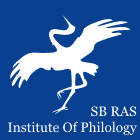 |
|
||||||||||||
|
Institute of Philology of
the Siberian Branch of Russian Academy of Sciences |
|
||||||||||||
|
|||||||||||||
| Sibirskii Filologicheskii Zhurnal (Siberian Journal of Philology) | |
|
Article
Authors: Olga Yu. Shagdurova, Elena V. Tyuntesheva Institute of Philology of the Siberian Branch of the Russian Academy of Sciences, Novosibirsk, Russian Federation In the section Linguistics
Abstract: We study the correlations between figurative-characterizing verbs in Turkic languages of Siberia (Altai, Khakas) and Kipchak languages (Kyrgyz, Kazakh, Bashkir). In these languages, we distinguish a small ancient group of figurative stems common for all Turkic, and sometimes also Mongolian and Tungusic languages. In the Altai and Khakass languages, there are commonalities and differences in the formation of complex words from figurative bases both between these languages themselves and with Kipchak. One common trait of these languages is the simultaneous formation of figurative-characterizing verbs and their Aktionsart meaning defined by an auxiliary verb (in analytic word formation) or certain affixes: =y characterizes a state while =ŋda ~ =ŋna ~ =ŋnaa denotes an evenly distributed meaning of action. The =(а)y affix is also found in the Mongolian language while =ŋda ~ =ŋna ~ =ŋnaa is typical for the Siberian and Kipchak languages. The difference in the formation of complex verbs with figurative-characterizing meaning lies in the usage of different verb components: Alt. et= ‘to do’; Khak. tüs= ‘to go down’, pol= ‘to be’, it= ‘to do’ (rarely); Kyrg., Kaz. et= ‘to do’, ber= ‘to take’, qaq= ‘to knock’, etc. The analysis of correlations has shown their small number among complex words and greater number among synthetic words, with a high number of Mongolian loanwords common for Siberian and Kipchak languages. In figurative-characterizing verbs, most correlations found in Siberian languages (without those in Kipchak) are derived from all-Turkic stems. No Altai-Kipchak correlations without their presence in the Khakass language were found, while there are a few correlations with Kyrgyz language. Also, no Khakas-Kipchak correlations were detected. Keywords: Turkic languages of Siberia, Kipchak languages, verb correlations, figurative words, semantics Bibliography: Ashmarin N. I. O morfologicheskikh kategoriyakh podrazhaniy v chuvashskom yazyke [On morphological categories of imitation in Chuvash]. Kazan, 1928, 187 p. Eginova S. D. Obraznye prilagatel’nye yakutskogo yazyka [Figurative adjectives of Yakut language]. Novosibirsk, Nauka, 2014, 231 p. Ganiev F. A. Obrazovanie slozhnykh slov v tatarskom yazyke [Formation of complex words in the Tatar language]. Moscow, Nauka, 1982, 149 p. Iskhakov A. I. O podrazhatel’nykh slovakh v kazakhskom yazyke [On imitative words in Kazakh]. In: Tyurkologicheskiy sbornik I [Turcological сollection I]. Moscow, Leningrad, 1951, pp. 103–111. Kharitonov L. N. Tipy glagol’noy osnovy v yakutskom yazyke [Types of verb stems in Yakut]. Moscow, Leningrad, AS USSSR Publ., 1954, 312 p. Kharitonov L. N. Formy glagol’nogo vida v yakutskom yazyke [Forms of Verb Aspect in Yakut]. Moscow, Leningrad, AS USSSR Publ., 1960, 179 p. Kile N. B. Obraznye slova nanayskogo yazyka [Figurative words in Nanai]. Leningrad, Nauka, 1973, 188 p. Kornilov G. E. Imitativy v chuvashskom yazyke [Imitative words in Chuvash]. Cheboksary, 1984, 291 p. Kozhoeva Zh. D., Akmatova D. S. Ob imitativakh v kirgizskom yazyke [On imitative words in Kyrgyz]. Philological Sciences. Issues of Theory and Practice. 2018, no. 9 (87), pt. 2, pp. 352–356. Rassadin V. I. Mongolo-buryatskie zaimstvovaniya v sibirskikh tyurkskikh yazykakh [Mon-golian-Buryat loan words in Siberian Turkic languages]. Moscow, Nauka, 1980, 115 p. Shagdarov L. D. Izobrazitel’nye slova v buryatskom yazyke [Figurative words in Buryat]. Ulan-Ude, Buryat Publ. H., 1962, 149 p. Shagdurova O. Yu. Obrazno-kharakterizuyushchie znacheniya mnogoznachnykh glagolov v khakasskom yazyke v sopostavlenii s tyurkskimi yazykami Yuzhnoy Sibiri [Figurative-characterizing meanings of polysemantic verbs in Khakas in contrast with Southern Siberian Turkic languages]. Vestnik of Novosibirsk State University. Series: “History and Philology”. 2012, vol. 11, iss. 9: Philology, pp. 110–114. Sundueva E. V. Affiksatsiya obraznykh slov v mongol’skom yazyke [Affixation of figurative words in Mongolian]. The world of science, culture and education. 2010, no. 1 (20), pp. 91–94. Tatarskaya grammatika [Tatar grammar]. Kazan, 1995, vol. 1, 582 p. Zhirkova E. E. Strukturnye osobennosti obraznoy i onomatopoeticheskoy leksiki yakutskogo i yaponskogo yazykov [Structural traits of figurative and onomatopoeic words in Yakut and Japanese]. Theoretical and Applied Linguistics. 2020, no. 6 (4), pp. 51‒60. |
 |
Institute of Philology Nikolaeva st., 8, Novosibirsk, 630090, Russian Federation +7-383-330-15-18, ifl@philology.nsc.ru |
© Institute of Philology |


